Meredith Allard's Blog, page 29
April 4, 2016
What I Learned About Writing from Coloring Books
As I’ve said before (in this post), I’ve joined the coloring book craze. I loved coloring when I was a kid, and as it happens I still love to color. I consider myself a wannabe crafter, and I used to dabble in painting with acrylics, and while coloring isn’t actually crafting or creating an original work of art, it still allows me to play with colors.

This is definitely one of my better pieces, maybe because I love peacocks.
I’ve found that, at least for me, there is a meditation-like quality to coloring because the coloring itself is all I’m thinking about while I’m engaged in the activity. I’m not worried about schoolwork I have to do, crazy professors, and all the writing I have to get through. All I’m thinking about is the page I’m coloring, what colored pencils, crayons, or markers I want to use, and which colors I think will look best. The more I have to do, the more I appreciate the simplicity of sitting down with some crayons and filling in the pictures.
As coloring became more popular, suddenly there were countless posts and articles about how to color. It’s similar to what happened with writing and indie publishing—suddenly there were all these experts shouting about the right way to do things. Something that should be relaxing and fun becomes stressful as we try to keep up. There’s nothing like an expert to take the fun out of something.
I had the realization (while coloring, of course) that my attitude toward coloring was the same as my attitude toward writing. I had to decide for myself how I wanted to color, just like I had to decide for myself how I wanted to write. Here are a few things I learned from coloring books and how they relate to writing:
Use the colors you want to use.
The experts in coloring will tell you to choose your palette first—use a color wheel to help you determine which colors to use. They’ll tell you which colors go with each other, and if you use that other color combination, look out! The Crayola Police will hunt you down. Hey, they say, that’s how painters do it, so that’s how coloring people should do it too!
And then I realized that I could use any color combination I want, just as I can write my stories however I want. I don’t like choosing my colors ahead of time. I like to choose my colors one by one as I’m coloring in the picture. Sometimes I have an overall idea of the color scheme I want to use, sometimes I don’t. Sometimes I’m happy with how the pictures turn out, sometimes I’m not. When I’m writing, I have an overall idea of how I want the story to turn out, but I’ve also learned to get out of my own way and allow the story to find its own path. If I prefer choosing my colors as I go as opposed to choosing them first then I can do that. If I prefer letting my stories find their own way, I can do that too.
Stop comparing yourself to others.
There are some amazing coloring websites out there where the coloring people post their finished pages. Some of those colored pages are indeed museum ready. They’re absolutely beautiful with shading and light and the way the colors blend together. My pictures don’t look like that (as you’ll see from the examples in this post). I love playing with colors, and some color combinations I try I like, some I don’t like as much, but so what? I wouldn’t know what I liked unless I allowed myself the freedom to experiment.
I have no desire to become a professional artist. Making myself crazy trying to make my pictures look like some of these artists’ pictures doesn’t work for me. I don’t have a lot of time to color because I’m so busy with other tasks, so when I do have time to color I don’t want to spend my time being stressed because my picture doesn’t look good enough compared to what other people can do. Where’s the fun in that?
Writers often have severe cases of compare-itis. We’re always looking to see which writers are selling more books, getting better reviews, or winning more awards than we are. We have to remind ourselves that we’re not in competition with other writers. This isn’t a race. Our careers as writers are just as unique as we are as people. No two writing careers are alike. We need to remember to focus on ourselves and helping our own careers move forward. Like runners, if we keep looking back to see who might overtake us we’ll lose steam and slow down.
Outline if you want to (and it’s okay to color outside the lines).
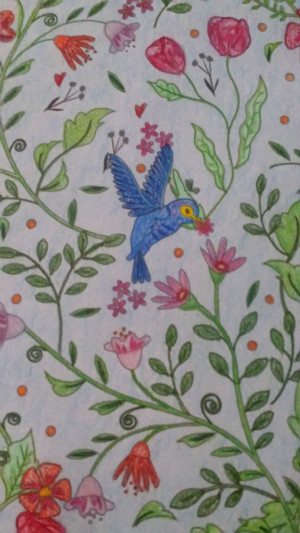
You can see that I outlined the leaves in dark green and filled them in with light green.
When I was reading posts of coloring tips, a number of the experts said not to outline your drawing. Apparently, with outlining you’re not going to have a realistic looking product and that’s not how the professionals do it. Oh well. I’ve always liked to outline my coloring pictures. Even when I was a kid I’d outline the shapes with whatever crayon I was using. A lot of times, I’ll outline with a darker color and fill in the shape with a lighter color (as evidenced in the picture to the left here), and I like the way that looks. Is it wrong? Not to me. It’s my coloring page and I’m going to do it the way I want to. It’s the same with coloring outside the lines. I like it when my coloring pencils or crayons end up outside the line because then when I’m filling in the next color they blend a bit. How maddening, to feel like your coloring page is all wrong if your hand slipped and some color ended up on the other side of the black line.
There are many posts out there for writers about the right way to do things. Write in these genres if you want to make money. Publish this many books a year. Set your books at these prices. Grow your social media presence and build your author platform. But what if you don’t want to limit your writing to certain genres, or what if you have another life outside of your writing like I do and you can only publish one book a year? Does that mean that you won’t have any career as a writer? Not at all. It means that you get to decide what kind of career you’re going to have. If I’ve learned anything over nearly five years as an author/publisher, it’s that I have to run my writing career the way I want to. I have to write my stories the way I want to write them, and if I color outside the lines with my words on occasion I’m okay with that.
Here are my own tips for coloring (and they apply to writing as well):
Choose what you want to color. You don’t have to start at the beginning of the book. You decide where to start. If you don’t love the picture, colorng it will be a chore. The same goes for writing. Write something you’re excited to get back to. If you’re not excited about it, it’s going to be hard to convince readers your writing is worth their time.
Choose your own colors. You can use a color wheel to examine which colors go together, or you can choose whatever you want to choose because you want to choose it. You can choose them ahead of time, or you can choose them in the moment, whichever feels right to you. For writing, you get to decide how you use language. You have the final say in how you’ll string phrases together. You may not like the way some of it turns out. That’s okay. You tried it, you didn’t like it, so try again until you find something you do like.
Don’t compare your pictures (or your writing) to anyone else. Find your own style.
Coloring (and writing) should be fun. Listen to your favorite music. Turn off your electronic devices and other distractions. Make your coloring (and your writing) time special so you’re looking forward to getting back to it.
You can let the experts tell you what to do and how to do it, or you can find your own way. Whether I’m coloring or writing, I find it a lot more fulfilling to find my own way.
Filed under: Spirituality, Writing Tagged: coloring, coloring books, creativity, writing, writing tips

March 18, 2016
The Book in Your Head Versus the Book Your Readers Read
Since February 9, When It Rained at Hembry Castle has sold over 1000 copies. Thank you! I’m sure there are other authors who can sell that many in a day, but I think those are pretty snazzy numbers.
After the release of my new book, I had an interesting conversation with a fellow author about what happens when you put a book out into the world. As writers, we spend hours, weeks, years living with a story, and then one day we have to set the story free. But what happens when other people (also known as readers) begin to read that story?
 I have a friend who is struggling with this issue while she’s getting ready to release her first novel, a venture into Steampunk complete with Victorianisms and fancy-pants machinery. The fear that nearly paralyzes her is the worry over bad reviews. I’ve tried to explain to her that it’s all part of the game. Every book gets bad reviews. I want you to check your favorite book’s Amazon page. I’ll wait. While you’re looking, you’re likely to see some bad reviews there.
I have a friend who is struggling with this issue while she’s getting ready to release her first novel, a venture into Steampunk complete with Victorianisms and fancy-pants machinery. The fear that nearly paralyzes her is the worry over bad reviews. I’ve tried to explain to her that it’s all part of the game. Every book gets bad reviews. I want you to check your favorite book’s Amazon page. I’ll wait. While you’re looking, you’re likely to see some bad reviews there.
I had a few things to say about negative reviews here. Focus on the people who like what you do, I say. They’re the ones who will look forward to your new releases. And if you really can’t handle book reviews, you can always do what I do—not read them. I kid you not. I don’t read reviews of my own books. My mother tried to catch me out once when I was talking about a movie review I had read. “I thought you said you don’t read reviews,” she said. What I said, I explained, is I don’t read my own reviews. I read other people’s reviews all the time.
The discussion with my friend about book reviews led into another conversation about the book writers think they’re writing versus the book the readers read. Think of it this way—when we’re writing a story, we know what we intend to do, why the pieces of the puzzle are set out the way they are, why this character says one thing when she means another. But when readers read, they’re not in our heads, they’re in their heads. Which is just as well. My head is crowded enough with only me in there. Readers have their own experiences, their own likes and dislikes, their own tastes. In the end, it doesn’t matter what I intended when I was crafting the story. To the readers, it only matters what happens when they engage with the story.
 Next, my friend asked how to write a novel that will appeal to everyone. The answer is you can’t. I mean, really, you can’t. I see articles all over Pinterest and Twitter with headlines like “10 Steps to an International Bestseller” or “How to Make Everyone Love Your Book” or “I Don’t Suck at Writing Anymore, and Now You Won’t Either” (for a fee, of course). Here’s the secret that’s not really a secret: you have to write something that could only come from you. I love this quote from Barbara Kingsolver because it explains the point far better than I ever could (yes, I found it on Pinterest): “Close the door. Write with no one looking over your shoulder. Don’t try to figure out what other people want to hear from you; figure out what you have to say. It’s the only thing you have to offer.” How true.
Next, my friend asked how to write a novel that will appeal to everyone. The answer is you can’t. I mean, really, you can’t. I see articles all over Pinterest and Twitter with headlines like “10 Steps to an International Bestseller” or “How to Make Everyone Love Your Book” or “I Don’t Suck at Writing Anymore, and Now You Won’t Either” (for a fee, of course). Here’s the secret that’s not really a secret: you have to write something that could only come from you. I love this quote from Barbara Kingsolver because it explains the point far better than I ever could (yes, I found it on Pinterest): “Close the door. Write with no one looking over your shoulder. Don’t try to figure out what other people want to hear from you; figure out what you have to say. It’s the only thing you have to offer.” How true.
When we write, we figure out what we have to say and we say it the very best way we know how. And if what people read is different than what we thought we were writing? As Toni Morrison once said to Oprah Winfrey, “That is called reading.” Readers are going to bring their own perspectives to the page. They’re going to see the characters and the events through their lens, not yours. And you know what? It’s all good. Many times readers see our stories in a completely different light than we intended, and often they see possibilities the writers never considered.
Here’s a case in point, and one close to my heart because it involves Hembry Castle. When I began writing Hembry in 2014, I had just come off the success of the Loving Husband Trilogy and I thought Hembry would be a great way to go back to writing a love story that readers would cheer for. Edward Ellis and Daphne Meriwether were always the focus for me as I was writing the novel. Yes, Daphne has to figure out how to live in this Downton Abbey-like world, but all along I saw When It Rained at Hembry Castle as a great love story. And here’s what happened…
Before I continue I should say that, while I don’t read reviews of my own books, I do read every email that comes my way. Readers who emailed me about Hembry weren’t gushing over Edward and Daphne. They were asking about Richard, Daphne’s uncle, the 9th Earl of Staton. In the reader’s mind (at least those who contacted me), Richard was the center of attention. He is the Earl of Staton, after all. But I was intrigued by their questions about Richard when to me Edward and Daphne are the stars of the show. Is it wrong for readers to focus on Richard? Of course not. But realizing that readers were not necessarily reading the book I thought I had written was a huge revelation to me and a continuing source of fascination.
Over the years, I’ve learned to keep my focus on writing the best stories I know how before sending those stories off into the world with my blessings. Everything else is beyond my control—even how readers respond to the books I’ve written. If, as writers, we can learn to make peace with that, then there will be much more smooth sailing ahead.
Filed under: Historical Fiction, When It Rained at Hembry Castle, Writing Tagged: book reviews, Downton Abbey, historical fiction, how to handle negative book reviews, When It Rained at Hembry Castle, writing, writing tips

March 10, 2016
A Hembry Castle Giveaway

I’ll be back next week with a new post, but in the meantime I thought I’d pass along the Amazon giveaway for When It Rained at Hembry Castle. It’s the easiest giveaway ever. Just click on this link and you’ll find out immediately if you’ve won. Fun, right?
Filed under: Giveaways, When It Rained at Hembry Castle Tagged: Amazon, Downton Abbey, Giveaways, historical fiction, When It Rained at Hembry Castle

February 24, 2016
Janet Fitch and Avoiding Clichés “Like the Plague”
First of all, thank you to those of you who helped to put When It Rained at Hembry Castle on the Amazon genre bestseller lists. As of this writing, the novel is #15 in the Literary Fiction British and Irish category. I don’t know who else would think to combine a love of Downton Abbey with a love for the books of Charles Dickens, but there you go.
I thought I’d repost this oldie but goodie from two years ago. To this day, I adhere to Janet Fitch’s idea that anything you’ve heard before is a cliché. That’s why I’m always stretching for unique descriptions.
Enjoy!
* * * * *
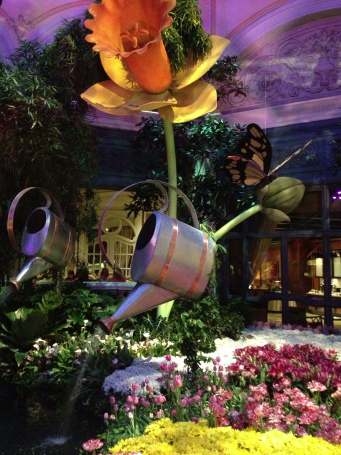 I’ve always had a hard time writing first drafts. You can see my tips for writing a first draft here. After I finish my first draft, that’s when I sit down at the computer no longer wanting to pop my eyes out with spoons or pluck my hairs one by one. Finally, in the second draft stage, I’m able to find the poetry in the prose. When I find the flow, that’s when the fun of writing begins for me. How do I find the flow? It’s a challenge, one that started 17 years ago.
I’ve always had a hard time writing first drafts. You can see my tips for writing a first draft here. After I finish my first draft, that’s when I sit down at the computer no longer wanting to pop my eyes out with spoons or pluck my hairs one by one. Finally, in the second draft stage, I’m able to find the poetry in the prose. When I find the flow, that’s when the fun of writing begins for me. How do I find the flow? It’s a challenge, one that started 17 years ago.
In 1999, Oprah Winfrey interviewed Janet Fitch, author of White Oleander, for the Oprah Book Club. Fitch talked about how a writing instructor told her that a “cliché is anything you’ve ever heard before—so never use a description anyone has heard.” As I remember it (it was 1999), Fitch spoke about a time she challenged herself to describe a tree with her own unique phrases. I was already well into fiction writing at that time, and her words struck me as truth. I learned that writers should reach to find their own descriptions, and they should never be lazy and allow others to do the work for them.
In a 2006 interview for O Magazine, Fitch explained that when she began writing fiction she had to work on word choices and the music of language. That was what I wanted too. I wanted to work on word choices and the music of language. I wanted to avoid clichés “like the plague” and create images “as sweet as pie.”
It’s a lesson I still hold close to my heart. When I’m molding sentences, I stretch, hands out, fingers pointing there, there where that inchoate image waits, sometimes patiently, sometimes not, for me to probe my vocabulary for the exactly right string of words to illuminate what I see the way I see it. If I’m describing a storm, a small town, a person, an emotion, I need to do it my own way. In their 2006 interview, Oprah mentions to Fitch that such a stretch “seems as if it would be quite difficult.” Fitch responds, “It is. But it means that everything you give the reader is absolutely fresh. We read so that we can be moved by a new way of looking at things.”
I learned a lot from Fitch in 1999, again in 2006, and I continue to learn from her whenever I read one of her novels. Reaching for phrases I’ve never heard before becomes harder with everything I write, but that’s the part of writing I thrive on—creating poetry in prose. And when I do finally find the right words, that is when I love having written.
If you’d like to lose yourself in the poetry of Janet Fitch’s prose, check out her novels or the short pieces on her blog. The 2006 interview for O Magazine can be found here.
Filed under: Writing Tagged: Avoiding Cliches, Janet Fitch, O Magazine, Oprah, White Oleander, writing tips

February 9, 2016
When It Rained at Hembry Castle is Now Available
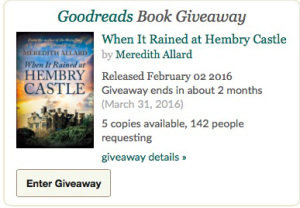
Enter the giveaway for a chance to win a paperback copy of When It Rained at Hembry Castle.
Finally! My first new novel in two years! When It Rained at Hembry Castle is now available on Amazon, BN, iTunes, and Kobo in ebook and paperback formats. The ebook is on sale for .99 cents from now until March 31 when it will go up to its regular price of $3.99. The paperback is $16.99.
Here’s the blurb:
From Meredith Allard, author of the bestselling Loving Husband Trilogy, comes When It Rained at Hembry Castle, a lush historical novel set in Victorian England. Perfect for fans of Downton Abbey, it’s the story of an aristocratic family, secrets that dare not be told, and the wonder of falling in love.
When the 8th Earl of Staton dies, his eldest son, the unreliable Richard, inherits the title and the family’s home—Hembry Castle. The Earl’s niece, the American-born Daphne Meriwether, is intrigued by Edward Ellis, a rising author with a first-hand knowledge of Hembry Castle—from the servants’ hall. And Edward, though captivated by the lovely Daphne, has his own hurdles he must overcome. Can Richard come to terms with his title before bringing ruin on his family? Will Edward and Daphne find their way to each other despite the obstacles of life at Hembry Castle?
When It Rained at Hembry Castle is a page-turning, romantic novel with vivid characters and an engrossing story that will keep you guessing until the end.
Buy When It Rained at Hembry Castle
Amazon
Amazon UK
BN
iTunes
Kobo
Add When It Rained at Hembry Castle:
Goodreads
Here’s the press release: Bestselling Author Meredith Allard to Publish a Downton Abbey Inspired Novel
Filed under: Historical Fiction, News, When It Rained at Hembry Castle Tagged: Downton Abbey, historical fiction, New Releases, Victorian fiction, When It Rained at Hembry Castle

January 29, 2016
Review Copies of Hembry Castle Are Now Available
Greetings! I just wanted to let everyone know that copies of When It Rained at Hembry Castle are available. The novel is technically up on Amazon (you can see it here), but the official release date isn’t until next week. I actually finished something early for a change. Go figure.
* * * * *
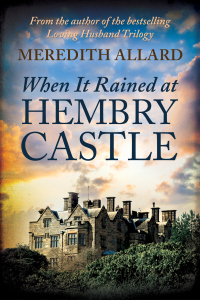 Here’s the official blurb:
Here’s the official blurb:
From Meredith Allard, author of the bestselling Loving Husband Trilogy, comes When It Rained at Hembry Castle, a lush historical novel set in Victorian England. Perfect for fans of Downton Abbey, it’s the story of an aristocratic family, secrets that dare not be told, and the wonder of falling in love.
When the 8th Earl of Staton dies, his eldest son, the unreliable Richard, inherits the title and the family’s home—Hembry Castle. The Earl’s niece, the American-born Daphne, is intrigued by Edward Ellis, a rising author with a first-hand knowledge of Hembry Castle—from the servants’ hall. And Edward, though captivated by the lovely Daphne, has his own hurdles he must overcome. Can Richard come to terms with his title before bringing ruin on his family? Will Edward and Daphne find their way to each other despite the obstacles of life at Hembry Castle?
When It Rained at Hembry Castle is a page-turning, romantic novel with vivid characters and an engrossing story that will keep you guessing until the end.
* * * * *
The book will be on sale for .99 cents through the end of March, though since you guys are special I’ll save you the buck (or the pound, or less than a pound, I suppose). If you’re interested in a review copy, email me at meredithallard(at)aol(dot)com and let me know if you’d like a pdf, mobi, or epub version.
Filed under: Historical Fiction, News, When It Rained at Hembry Castle Tagged: Downton Abbey, historical fiction, New Releases, News, Victorian fiction, When It Rained at Hembry Castle

January 25, 2016
Creative Inspiration For Writing Historical Fiction
There’s a joke I’ve seen on Pinterest, a cartoon of a writer watching TV. The character says, “I’m researching!” to the cynical-looking people standing nearby. For those of us who write fiction, we know that watching TV or movies, listening to music, or going for walks really is research because all of it becomes part of the writing process. Writers, especially fiction writers, need their imagination fueled regularly, and it’s the little things we do, such as stealing an hour here or there to watch a favorite TV show or listen to our favorite music, that help to fill the creative well so that we have a brain full of ideas when we sit down to write.
When it comes time to write, especially if I’m writing an historical story, I try to immerse myself in the time period as much as possible. If I feel as if I’ve traveled back in time, then it’s easier for me to carry my readers along with me on the journey. Here are some of the places I found inspiration while writing When It Rained at Hembry Castle. My hope is that by reading over my list, writers of historical fiction will discover places to find inspiration of their own.
Books
Nonfiction:
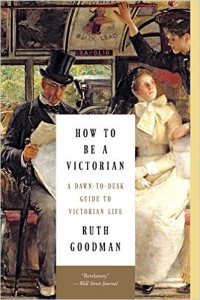 Up and Down Stairs: The History of the Country House Servant by Jeremy Musson
Up and Down Stairs: The History of the Country House Servant by Jeremy Musson
What Jane Austen Ate and Charles Dickens Knew by Daniel Pool
How To Be a Victorian: A Dusk-to-Dawn Guide to Victorian Life by Ruth Goodman (one of my new favorite historians—she lives what she studies)
The Victorian City: Everyday Life in Dickens’ London and Inside the Victorian Home: A Portrait of Domestic Life in Victorian England by Judith Flanders
The Writer’s Guide to Everyday Life in Regency and Victorian England From 1811-1901 by Kristine Hughes
To Marry an English Lord by Gail MacColl and Carol McD. Wallace
Below Stairs: The Classic Kitchen Maid’s Memoir That Inspired “Upstairs, Downstairs” and “Downton Abbey” by Margaret Powell
The Essential Handbook of Victorian Etiquette by Thomas E. Hill
Fiction:
When reading novels, I look for books written during the era I’m writing about as well as novels written about the era. Other times I’ll find inspiration in a novel that isn’t necessarily set in that time period but there’s something about the story that provides some ideas.
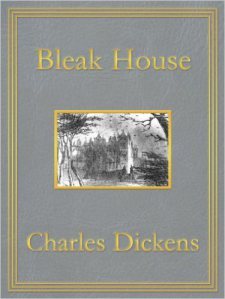 The Buccaneers and The Age of Innocence by Edith Wharton
The Buccaneers and The Age of Innocence by Edith Wharton
Snobs by Julian Fellowes
The Remains of the Day by Kazuo Ishiguro
I read A LOT of P.G. Wodehouse (but really, can you read too much Wodehouse?)
I read A LOT of Dickens (but really, can you read too much Dickens?)
Wolf Hall and Bring Up the Bodies by Hilary Mantel (set in the Tudor era—I know—but she’s such a master of historical fiction I needed to read the books again)
Television and Film
For me, TV and film are the same as fiction—some of what I watch is set in the era, some is not, but all stir my imagination in one way or another.
Downton Abbey (Surprised, right?)
Upstairs, Downstairs
The miniseries of The Buccaneers
North and South
Lark Rise to Candleford
Cranford
Pride and Prejudice (Colin Firth’s version)
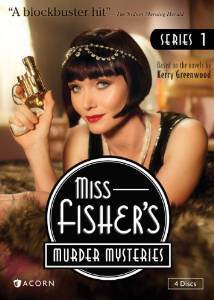 Sense and Sensibility (Emma Thompson’s—and Alan Rickman’s—version)
Sense and Sensibility (Emma Thompson’s—and Alan Rickman’s—version)
I tried to watch the TV versions of Bleak House and Great Expectations, but to be honest screen adaptations of Dickens’ work rarely thrill me. They get the drama down all right, but you’d never guess Dickens was one of the funniest authors in the English language from the dreariness of the adaptations. I’m doing a little better with Dickensian, if for nothing else but Stephen Rea’s performance as Inspector Bucket.
Keeping Up Appearances—Another Bucket (It’s BooKAY).
Miss Fisher’s Murder Mysteries—this outstanding Australian show is set in the 1920s, but I love Essie Davis’ Phryne Fisher so much I’ll use any excuse to watch it. Phryne Fisher’s clothes are even more fabulous than the costumes on Downton Abbey. If you have Netflix, give it a try.
Music
Since my Victorian story is set in the 1870s, people were dancing to waltzes and polkas. Strauss and Chopin were favorite composers, which works well for me since I love to listen to classical music.
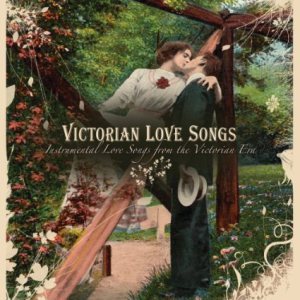 I was also able to find a few mp3s of Victorian-era music. I wasn’t concerned with whether or not these were songs specifically from the 1870s, and the music didn’t necessarily make it into the novel, but I really enjoy listening to music from the general time period while I’m writing. It helps me get into the right frame of mind. Here are a few examples of what I found:
I was also able to find a few mp3s of Victorian-era music. I wasn’t concerned with whether or not these were songs specifically from the 1870s, and the music didn’t necessarily make it into the novel, but I really enjoy listening to music from the general time period while I’m writing. It helps me get into the right frame of mind. Here are a few examples of what I found:
Victorian Dining by Peter Breiner and Don Gillis
Victorian Edwardian by Alexander Faris
Victorian Love Songs by Craig Duncan
If you’re writing historical fiction, I highly recommend listening to music from the era while you write. I find a lot of great songs on Amazon, and if you have Amazon Prime then you can listen to some of the music for free.
I adore Pinterest. For me, Pinterest isn’t social media marketing as much as something I do for fun because I love it so much. When It Rained at Hembry Castle is the first novel I’ve written since I started on Pinterest, so it’s the first time I was able to use pictures from the site to inspire my writing. When I needed to describe the sitting room at Hembry Castle, for example, I simply needed to go onto my research board, find the pin for the photograph I wanted to use as inspiration, and describe what I saw. If you’re writing your novel on Scrivener, you can import those photos directly into your novel file so they’re readily available when you need them.
When I was researching the novel, I created a private board for Hembry Castle because I didn’t want to bombard my followers with my many research pins. Then, when I had everything I needed, I created a public board so people could see the inspiration behind the story. Want to check out the board? It’s here.
Travel
I had a few things to say about traveling for research purposes in this post. Of course, it’s not always possible to travel, but if you can then do.
London, England: I’ll have more to say about my journeys to London for research purposes in a later post. For now, I’ll say that London is always a good idea.
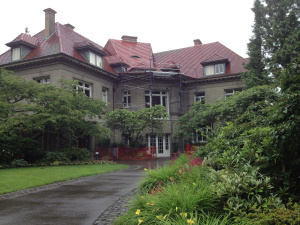
Pittock Mansion in Portland, Oregon
Portland, Oregon: An odd place to travel when researching a novel set in Victorian England, I know. I didn’t actually travel there for that purpose, but when I arrived I found Pittock Mansion, an American, smaller-scale version of an English country house, and Pittock Mansion provided a lot of inspiration for Hembry Castle. In fact, the music room and the library in Hembry Castle were modeled after rooms in Pittock Mansion.
This is just the short list of places where I found inspiration for my Victorian historical novel. I hope you’ve discovered a few ideas for places you might seek inspiration for your own historical stories, whichever era they’re set in.
Filed under: Historical Fiction, When It Rained at Hembry Castle, Writing Tagged: historical fiction writing tips, When It Rained at Hembry Castle, writing, writing historical fiction, writing tips

January 11, 2016
Nothing is Set in Stone: Allowing Room For Freedom When Writing Fiction
First of all, I hope everyone had a wonderful holiday season. I took a couple of weeks off for the holidays, and then a bout of the flu kept me down for a bit. I ended up spending most of my Christmas break revising When It Rained at Hembry Castle. The novel is in its final edits phase, and I’ll have galley copies in print and ebook in a week or two in case any of you would like a free review copy. I’ll send out word when they’re available. If you’re interested, just contact me at my email address: meredithallard(at)aol(dot)com. In fact, I just started a new Pinterest board for the novel with photographs I used for inspiration for clothing, settings, and characters. If you’re interested in the Victorian era, or in the novel, by all means check out the board. I’ll be adding more pins every day.

Scotney Castle–one of the influences for Hembry Castle and the castle used on the book cover.
This is always the point of writing a new novel where I’m reminded of Dorothy Parker’s great saying: I hate writing but love having written. I admit that Hembry was difficult for me to grasp ahold of. I hadn’t struggled like that with a novel since I wrote Her Dear & Loving Husband from 2009-2011. Her Dear & Loving Husband was the most complicated plot I had written up to that point, and I had a lot of trouble understanding how to make the past and present storylines work. It wasn’t until I had the novel professionally critiqued that I understood the flow of the story, and then once I figured it out writing the next two books in the series, Her Loving Husband’s Curse and Her Loving Husband’s Return, came easily because they followed the same plot structure. My next novel, That You Are Here, was such a dream to write. For whatever reason, there were no struggles with that book. I understood who the characters were immediately, and I saw the story play out like a movie, which meant all I had to do was take dictation. The book took me four months to write—a crazy-quick time, at least for me.
Again, with When It Rained at Hembry Castle there were struggles. In a sense I was back to where I was when I wrote Her Dear & Loving Husband—I had this whole new world I had to figure out. The plot for When It Rained at Hembry Castle became the most difficult plot I had yet undertaken, even more so than the plots in the Loving Husband Trilogy. In the Loving Husband Trilogy there are two points of view, from the two romantic leads, James and Sarah, and two time periods, the present and whichever historical period that novel is set. In When It Rained at Hembry Castle, I initially thought I would use the same two person point of view as I had in the Loving Husband Trilogy, but after beating myself about the head for a few months trying to make it work, I realized that two points of view were not enough for this novel. In keeping with its Downton Abbey inspiration, there are upstairs stories and downstairs stories in Hembry, and I finally realized that I needed more points of view in order to make this work. I haven’t yet tried the head-hopping omniscient third person point of view (one of these days I’ll write a novel where I try that one), but for Hembry I opened the field so that we get the point of view of more than just the two romantic leads (in this case, Edward and Daphne). I limited the scope of POV to one character for each chapter–this way it isn’t difficult for the reader to follow.
 For me, that’s the frustration (and the fun) of writing fiction. Anything goes, which means sometimes it takes a while to figure out exactly what you need to do to bring each new story to life. The two person point of view worked well for the Loving Husband Trilogy, so I assumed it would work for Hembry. It didn’t. There are too many characters in Hembry, and there’s too much going on for my two romantic leads to be everywhere. I needed to let some of the other characters have their moments in the sun. Once I allowed the characters the freedom to speak for themselves, the headaches started to go away and the novel started to resemble the story I wanted to write in the first place.
For me, that’s the frustration (and the fun) of writing fiction. Anything goes, which means sometimes it takes a while to figure out exactly what you need to do to bring each new story to life. The two person point of view worked well for the Loving Husband Trilogy, so I assumed it would work for Hembry. It didn’t. There are too many characters in Hembry, and there’s too much going on for my two romantic leads to be everywhere. I needed to let some of the other characters have their moments in the sun. Once I allowed the characters the freedom to speak for themselves, the headaches started to go away and the novel started to resemble the story I wanted to write in the first place.
Once I understand the plot structure and the way the pieces fit together, that’s when I’m in the flow of writing and there’s nowhere else in the world I’d rather be. The first part of writing a novel has always been difficult for me. That’s when I flap about like a fish out of water (or an asthmatic without an inhaler—speaking from experience), spending hours writing scenes that don’t make sense and have nothing to do with the story I want to tell. Every time I’m about to give up, though, I force myself to keep going because I’ve been at this long enough to know that the “shitty first draft” phase will pass and the story will reveal itself in the end. How much hair I have in the end always remains to be seen, but bald or not bald, I know that I’ll figure out whatever it is that’s not working. This is something I need to relearn every time I write a new novel, but most especially whenever I start a novel set in a new world. I also need to remind myself that nothing is set in stone, and I can experiment, play, and try things until I find the winning combination. I could have imposed the two person point of view on Hembry because I know that works and I’ve had success with it before. But it didn’t work in this story, in this world, and I needed to allow myself the freedom to play around until I discovered what did work. Of course, now that all the heavy lifting is done, I can say that I love having written.
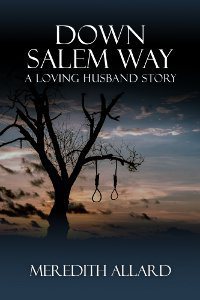 For you Loving Husband Trilogy fans, God bless your patience. Even when you email me to say “You said the new story was coming out last spring…?” you’re so kind and encouraging. You guys are great! I had to get When It Rained at Hembry Castle out of my system, and it took me longer to write than I expected. Now that it’s done, I promise (cross my heart) that Down Salem Way is coming out this June. Yes, as a fan stated, but that’s still six months away. I hear you. I’m going to try to get it out sooner if at all possible, but the same holds true with the new James and Sarah story as with anything I write—I won’t publish something if I’m not happy with it. I’m not going to do a slap-dash job with Down Salem Way just to get it out there. I’d rather take my time to make sure it’s the very best it can be. After all, you guys have waited long enough for a new James and Sarah story—it better be a good one, right?
For you Loving Husband Trilogy fans, God bless your patience. Even when you email me to say “You said the new story was coming out last spring…?” you’re so kind and encouraging. You guys are great! I had to get When It Rained at Hembry Castle out of my system, and it took me longer to write than I expected. Now that it’s done, I promise (cross my heart) that Down Salem Way is coming out this June. Yes, as a fan stated, but that’s still six months away. I hear you. I’m going to try to get it out sooner if at all possible, but the same holds true with the new James and Sarah story as with anything I write—I won’t publish something if I’m not happy with it. I’m not going to do a slap-dash job with Down Salem Way just to get it out there. I’d rather take my time to make sure it’s the very best it can be. After all, you guys have waited long enough for a new James and Sarah story—it better be a good one, right?
Happy 2016!
Filed under: Down Salem Way, Her Dear & Loving Husband, Her Loving Husband's Curse, Her Loving Husband's Return, When It Rained at Hembry Castle, Writing Tagged: creative writing, Down Salem Way, Downton Abbey, Fiction Writing, The Loving Husband Trilogy, When It Rained at Hembry Castle, writing, writing tips

December 22, 2015
Christmas at Hembry Castle: An Excerpt
Happy holidays! Normally this time of year I post a chapter from Dickens’ A Christmas Carol, but since I’ve nearly finished revising my new novel, When It Rained at Hembry Castle, and there just so happens to be two Christmas chapters, I thought I’d share those instead. For those of you who have been following the progress of the new novel, you know it’s set in Victorian England (in 1870) and loosely inspired by Downton Abbey (which is set later than the Victorian period–yes, I know).
Today’s chapter, entitled what else but “Christmas at Hembry,” currently stands as Chapter 17, though that could easily change by the time the novel is released in February. This isn’t a finished product, and I never show my unfinished products to anyone. But since we’re among friends, I thought I’d share. Enjoy!
* * * * *
 Christmas at Hembry was glorious. The same rooms that felt cavernous and cold the rest of the year glowed gold and warm from the candelabras and hearth fires that waved holiday cheer to all. Every surface in every room was covered with berried evergreens while mistletoe draped the walls and baskets of clove-wrapped oranges scented the air. The centerpiece of the castle was a 15-foot-tall tree lit with white candles and decorated with paper chains, strung candies, ribbons, and tinsel, all presents from the village children who gasped with delight to see their handmade gifts on display in the grand old house. Even the Countess of Staton was softened by the glee of the season, and she seemed almost dreamy as she floated about, her wind blowing a few degrees less coolly, and she entertained Daphne with memories of her sons’ first Christmastides. She named every present her sons had ever presented her, every mischief they had found themselves in. In the darkness, descending early now, Lady Staton spent hours with Daphne by the hearth in the sitting room over steaming cups of tea and lemon biscuits to tell stories of Frederick’s antics as a boy, like the time he meant to give his nanny a frog as a holiday gift and the slimy thing leapt first into Nanny’s apron pocket and then down the front of her dress. Oh, how she screamed, Lady Staton said, nodding at the memory. Lady Staton told Daphne how Prince Albert had brought his country’s Christmas traditions, including Christmas trees, to Windsor Castle in 1841. “And if Queen Victoria had a Christmas tree,” the Countess said, “then all of England wanted a Christmas tree.”
Christmas at Hembry was glorious. The same rooms that felt cavernous and cold the rest of the year glowed gold and warm from the candelabras and hearth fires that waved holiday cheer to all. Every surface in every room was covered with berried evergreens while mistletoe draped the walls and baskets of clove-wrapped oranges scented the air. The centerpiece of the castle was a 15-foot-tall tree lit with white candles and decorated with paper chains, strung candies, ribbons, and tinsel, all presents from the village children who gasped with delight to see their handmade gifts on display in the grand old house. Even the Countess of Staton was softened by the glee of the season, and she seemed almost dreamy as she floated about, her wind blowing a few degrees less coolly, and she entertained Daphne with memories of her sons’ first Christmastides. She named every present her sons had ever presented her, every mischief they had found themselves in. In the darkness, descending early now, Lady Staton spent hours with Daphne by the hearth in the sitting room over steaming cups of tea and lemon biscuits to tell stories of Frederick’s antics as a boy, like the time he meant to give his nanny a frog as a holiday gift and the slimy thing leapt first into Nanny’s apron pocket and then down the front of her dress. Oh, how she screamed, Lady Staton said, nodding at the memory. Lady Staton told Daphne how Prince Albert had brought his country’s Christmas traditions, including Christmas trees, to Windsor Castle in 1841. “And if Queen Victoria had a Christmas tree,” the Countess said, “then all of England wanted a Christmas tree.”
“We have Christmas trees in America,” Daphne said. “They add such a festive feeling to the season. And the candlelight is so beautiful.” When Lady Staton started in her chair, Daphne said, “Yes, even we Americans are civilized enough to have Christmas trees.” To Daphne’s surprise, her grandmother laughed. A Christmas miracle indeed.
The day itself was snowy, and iridescent light filtered from the quilted gray sky. The castle was full, as it was every year, with family, villagers, farmers, tradesmen, and anyone else important to the castle and its people. They had gathered together, as was the 250-year-old tradition, to eat and drink to their heart’s content, sing carols, and dance like there was no tomorrow. Daphne clasped her hands together when she saw two faces that made her particularly joyous: her Uncle Richard and Edward Ellis. Uncle Richard had disappeared without a trace a few weeks before, his only contact a cryptic message to her father about how he had pressing business but would be back at Hembry for the holidays. Despite her father’s best efforts, Richard couldn’t be found, and when her uncle turned up unexpectedly on Christmas Eve, everyone was so relieved they let his latest disappearing act pass without comment. Though it had only been a day since his return, Daphne saw her uncle smiling, easy, relaxed—as though some great weight, some strangulating albatross, had been removed from his neck once and for all and he moved all the lighter for it. She watched her uncle move among his guests, chatting with the farmers and villagers, laughing with the servants, dancing with his mother, all the time looking over the gathering as though he could hardly believe he was there. Daphne watched her uncle dance with a ten-year-old village girl, who positively beamed.
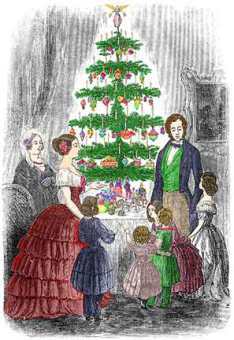 Edward Ellis’s arrival had a very different effect. He arrived in the afternoon, making his excuses to her father, apologizing for his tardiness, but he had wanted to spend some time that day with his family in London. Edward looked at his grandfather, who stood in his usual hunched manner with his hands behind his back. Mr. Ellis looked very pleased indeed with the turnout at Hembry Castle, and he watched the festivities over his round-rimmed spectacles, nodding at everyone and everything he saw. “I’m grateful to be here now, Mr. Meriwether,” Edward said. “I’ve always wanted to spend Christmas with my grandparents.”
Edward Ellis’s arrival had a very different effect. He arrived in the afternoon, making his excuses to her father, apologizing for his tardiness, but he had wanted to spend some time that day with his family in London. Edward looked at his grandfather, who stood in his usual hunched manner with his hands behind his back. Mr. Ellis looked very pleased indeed with the turnout at Hembry Castle, and he watched the festivities over his round-rimmed spectacles, nodding at everyone and everything he saw. “I’m grateful to be here now, Mr. Meriwether,” Edward said. “I’ve always wanted to spend Christmas with my grandparents.”
Frederick clasped Edward’s shoulder and steered the young man toward the steaming punch bowl. “I’m so pleased you’re here now, Edward, as is Daphne. I know your grandparents have been looking forward to this since you agreed to come.”
Frederick excused himself to see about Mrs. Pearson, a village widow whose son, Joseph, had been ill. Frederick spoke softly to the doctor, Mr. Hough, and the men approached the woman and her small boy, giving the little fellow some peppermint and molasses taffy to put a smile on his face. Frederick then led the boy to the sitting room where a pantomime put on by the village children was in full swing.
“Who is that?” Edward asked as he watched Frederick and the boy. After Daphne explained, Edward said, “That’s good of your father to take such an interest. And you.”
“Papa and I have been to their cottage a few times to see how Joseph was doing. At first he seemed better, but then he was ill again. Mr. Hough saw Joseph yesterday, but he isn’t sure what’s wrong with the poor boy. He doesn’t have a fever, and he doesn’t have the chills. He’s just ill. Mr. Hough left a note with directions about how to care for the boy, and we’ve been following his instructions to the letter.”
“It must be working. The boy looks well enough.”
“He does, doesn’t he? Let’s hope that’s a good sign.”
Daphne saw little Joseph begin clapping when carolers began singing:
God rest ye merry, gentlemen
Let nothing you dismay
Remember, Christ, our Saviour
Was born on Christmas day
To save us all from Satan’s power
When we were gone astray
O tidings of comfort and joy,
Comfort and joy
O tidings of comfort and joy.
When the song was done, the orchestra began an upbeat tune and dancers filed into the center of the Great Hall to bow or curtsey before taking off down the rows on their toes. It was a beautiful scene, Daphne thought, as family, villagers, and anyone else who wanted laughed like children and danced before the great tree. Mothers danced with their sons, daughters with their fathers. The Earl of Staton danced with the baker’s wife and the peacock of a first footman danced with the Marchioness of Braddleton. Edward laughed when his grandfather took his grandmother for a swing around and around. He looked at Daphne and nodded toward the dancers.
“Miss Meriwether, may I have this dance?”
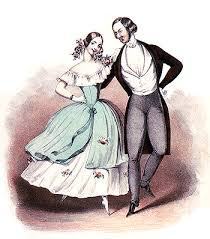 Daphne curtsied, and she joined Edward with the others. As soon as she started moving she forgot about everyone else. She forgot about the holiday decorations and the tables of delicious foods. She forgot the music and the very walls holding up the castle around her. She was with Edward, his left hand on her hip, his right hand holding hers. He looked nowhere but into her eyes, and she into his. His eyes were very green then, Daphne thought, spring green, green like new life and green like hope and dreams. He smiled at her, and she expected a comic comment from him as was his way, but he only smiled, and she smiled too. A space opened around them, and Edward twirled Daphne so her red velvet dress flared behind her. She felt as though she waltzed on air. When the music stopped and the others clapped, Edward and Daphne clapped too, Daphne still dizzy with exhilaration.
Daphne curtsied, and she joined Edward with the others. As soon as she started moving she forgot about everyone else. She forgot about the holiday decorations and the tables of delicious foods. She forgot the music and the very walls holding up the castle around her. She was with Edward, his left hand on her hip, his right hand holding hers. He looked nowhere but into her eyes, and she into his. His eyes were very green then, Daphne thought, spring green, green like new life and green like hope and dreams. He smiled at her, and she expected a comic comment from him as was his way, but he only smiled, and she smiled too. A space opened around them, and Edward twirled Daphne so her red velvet dress flared behind her. She felt as though she waltzed on air. When the music stopped and the others clapped, Edward and Daphne clapped too, Daphne still dizzy with exhilaration.
When the next song began, Edward grabbed Daphne’s hand and led her to the empty seats nearest the hearth. He opened his mouth, about to speak, but then he looked from the dancers to the Christmas tree to his grandparents, who were close in conversation and glancing in their direction. Edward reached beneath his black frock coat, his green and red paisley cravat falling out from his green velvet waistcoat while he fumbled in his pocket. After an anxious moment, he pulled out a small green box. He looked around, but though the room was full everyone was so caught up in their own frivolity they didn’t notice the chocolate-haired, nervous-looking young man and the small box he handed to the golden-haired, glowing young woman.
“My grandparents would say I’m being too forward, but I wish you’d accept this in the spirit it’s intended—a gift between friends.”
Daphne turned the box over in her hands. “May I?”
“Please.”
She gasped at the ruby earrings inside. Perhaps the gems weren’t of the same quality as the heart-shaped ruby ring her grandmother had given her, but they were perfect—small, round, set in filigree gold.
“You’re not offended?” Edward asked.
“Offended? They’re beautiful. Come here.” Without thinking of the hundreds of people in the castle, without thinking of anything but the present she had for Edward, she led him across the room and around the dancers to the ceiling-high tree. She knelt by the white-lace skirt at the bottom and reached around the back, pulling out a gold-wrapped box with a sprig of holly.
“This is my present for you.” She handed Edward the gift and waited with clasped hands while he opened it—a copy of A Christmas Carol signed by Mr. Dickens himself.
Edward turned the book from front to back to side to front again. “You must have contacts beyond the grave.”
Daphne laughed. “Not quite. My father and I found it in a bookshop on the Strand in London. As soon as I saw it I thought of you, the soon-to-be famous author. Your book will be out before long, and who knows? Maybe you really will be the next Mr. Dickens.” She pointed to the inside flap of the book. “In case you were wondering, that is definitely Mr. Dickens’ signature. My father had it examined. Someone must not have known what they had when they sold the book.”
Edward stepped closer to her, closing the space between them. “I know exactly what I have.”
Daphne wanted him to look at her that way all the Christmas day, with an intensity she had never seen from him before. When the musicians played a waltz, Edward held out his hand. Daphne curtsied, and again he twirled her across the dance floor, and again her ruby-red dress fanned behind her, and again she felt lifted by the air.
This time, however, Daphne was aware of the others in the room, and she felt their eyes following her every move. Her grandmother squinted at them while she held her ear trumpet in place to hear her Uncle Jerrold and his wife Hyacinth, who had her monocle to her eye so as not to miss a detail. Her Uncle Richard leaned close to John Hough and whispered. Her father watched them too, exchanging sly looks with his lordship and Mr. Hough.
 For the first time that Christmas Day, Daphne realized what she had done. By speaking so publicly to Edward, by dancing with him to the exclusion of everyone else, by sharing their gifts in this public space, she had made a choice. Most likely everyone in the castle knew how she felt about him by now. It had to be obvious in the way she felt light on her feet and grinned like a silly girl and laughed at anything he said however he said it.
For the first time that Christmas Day, Daphne realized what she had done. By speaking so publicly to Edward, by dancing with him to the exclusion of everyone else, by sharing their gifts in this public space, she had made a choice. Most likely everyone in the castle knew how she felt about him by now. It had to be obvious in the way she felt light on her feet and grinned like a silly girl and laughed at anything he said however he said it.
So let it be, Daphne thought. While Edward hasn’t made any declarations yet, she guessed he felt the same for her as she did for him. She had to follow her heart, and her heart led to Edward Ellis.
Filed under: Fiction, Historical Fiction, When It Rained at Hembry Castle Tagged: Christmas Stories, fiction, historical fiction, When It Rained at Hembry Castle

November 23, 2015
Are You Making Changes? Are You Pursuing Your Passion?

Gilcrease Orchard Autumn 2015
Earlier this year I wrote about making changes. First, I wrote a post called Wherever You Go, Go With All Your Heart about how I had decided to become a PhD student after dreaming about it for many years. Then I wrote Hello, Goodbye: Changes Are Good for the Soul. And I still wasn’t finished making changes.
I was fortunate enough to receive a Graduate Assistant position at my university, and while the pay is below poverty wages (no joke), I wanted the experience of teaching and researching at the university level, so that was another change I made—leaving behind my full time teaching job for a G.A. position. One thing I gained from leaving behind my full time job was the gift of time. Certainly, I’m busy with university obligations, but otherwise time has opened up for me in a way it never had before. For years I wanted to put together an anthology of historical short fiction by contributors from The Copperfield Review. With my new-found time, I was able to put the anthology together, and History Will Be Kind is finally out in the world. My current writing project, the historical novel that drove me batty over the summer, is now full speed ahead and looking good for its February release. For my studies I was fortunate enough to have stumbled onto a research subject that fascinates me, and I’m finding this time at UNLV invigorating in a way I hadn’t expected.
I mention this because I’ve recently become aware of Steven Pressfield’s concept of the shadow career. In his book Turning Pro, one of the examples Pressfield uses is “Are you getting your PhD in Elizabethan Studies because you’re afraid to write the tragedies and comedies that you know you have inside you?” First of all, I’m getting my PhD in Teacher Education, not Elizabethan Studies, thank you very much, and second of all, no, I’m not afraid to write the tragedies and comedies I have inside me. Then I realized Pressfield isn’t speaking to people who have a go at realizing their dreams—he’s referring to people who don’t pursue their passions. He points out the dichotomy between artists and addicts, an addict in this case meaning a self-sabotaging amateur who distracts herself away from her true passion with distractions, displacement activities, and meaningless jobs. Instead of pursuing our true callings, Pressfield says, we hide behind shadow careers.
 I’ve spoken to many people over the years who have a burning desire to be a writer yet they don’t write. I have a friend, a fellow teacher, who has been wanting to write a mystery novel for as long as I’ve known her (nearly 10 years now). She reads mystery novels, reads about how to write mystery novels, and she even travels across the U.S. to attend the Sisters in Crime conventions. I’ve often wondered what’s really holding her back. Whenever I think of people like my friend, I remember that quote from Maya Angelou in I Know Why the Caged Bird Sings: “There is no greater agony than bearing an untold story inside you.” I wish I could help my friend realize it’s okay, you can do it, you don’t need permission from anyone, do what you can do right now. I think sometimes people are so afraid of making any kind of change they make excuses and talk themselves out of doing something that’s calling to them from deep in their hearts.
I’ve spoken to many people over the years who have a burning desire to be a writer yet they don’t write. I have a friend, a fellow teacher, who has been wanting to write a mystery novel for as long as I’ve known her (nearly 10 years now). She reads mystery novels, reads about how to write mystery novels, and she even travels across the U.S. to attend the Sisters in Crime conventions. I’ve often wondered what’s really holding her back. Whenever I think of people like my friend, I remember that quote from Maya Angelou in I Know Why the Caged Bird Sings: “There is no greater agony than bearing an untold story inside you.” I wish I could help my friend realize it’s okay, you can do it, you don’t need permission from anyone, do what you can do right now. I think sometimes people are so afraid of making any kind of change they make excuses and talk themselves out of doing something that’s calling to them from deep in their hearts.
The funny thing is, I don’t think being a teacher is a shadow career for my friend. I think she genuinely enjoys teaching. The problem isn’t that my friend isn’t making a living as a mystery novelist. The problem is that she isn’t pursuing her passion. Yes, it’s hard to find time to write when you’re a teacher (there’s always so much lesson planning and grading to do), but I believe that if you want to do something badly enough you’ll find a way to make it happen. I wrote seven novels and edited The Copperfield Review while working as a full time teacher. Why? Because I had to. I had untold stories burning holes in my innards and I couldn’t live with the agony of not sharing them. Pursuing my PhD isn’t my way of turning from those untold stories. I’m still writing novels—yes, it takes me longer these days to finish one, but I’m still writing them, and I’m still running The Copperfield Review. And since I love writing so much, when I’m teaching writing I feel like I’ve come home. As a result, I’m researching what can be done to train future writing teachers, and it’s fascinating stuff, let me tell you. You might have several passions as I do, and yes, it’s a challenge to juggle them, but it’s worth it. If you’re pursuing your passion and have a day job, I refer to my post about day jobs. I will insist, always, that you are not less of an artist if you have a day job. As long as you make time for your art, you are an artist. Even if my friend writes 500 words a day, 250 words a day, 100 words a day, whatever it is, it’s allowing her to pursue her passion at a pace that’s right for her. Don’t listen to the people who want to tell you how to be a writer (or a painter, or a dancer, or a photographer, or an underwater basket weaver). Don’t listen to the people who want to tell you that you’re not a writer unless you write a certain number of words every day (that is, unless it’s November and you’re participating in NaNoWriMo. Then 1667 words a day is about right). You get to decide how to be an artist for yourself. Really.
Not everyone’s journey is the same, but we’re all going to need to make changes at one point or another. Yes, changes are scary, but if you need to make a change, make it. If you have a passion, pursue it, in whatever form you can right now. Life is too short not to listen to whatever it is that makes your heart sing.
Filed under: Spirituality, Writing Tagged: follow your dreams, making changes, personal passions, writing




